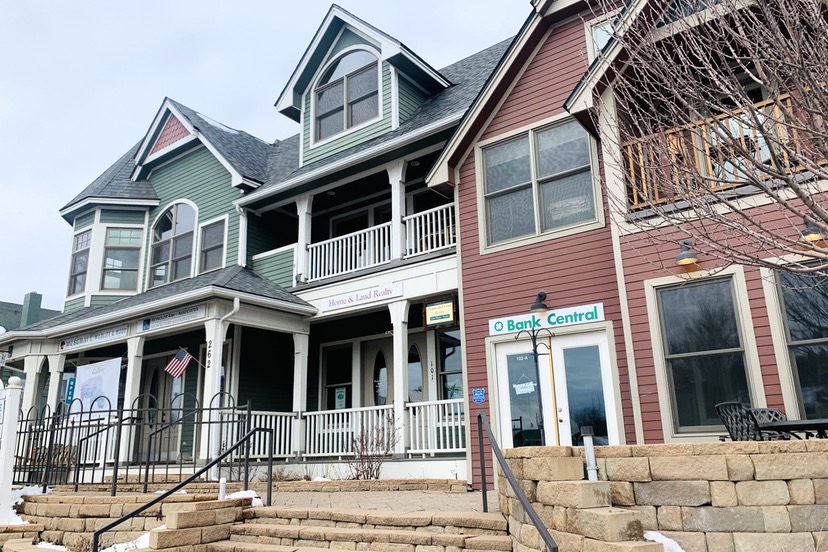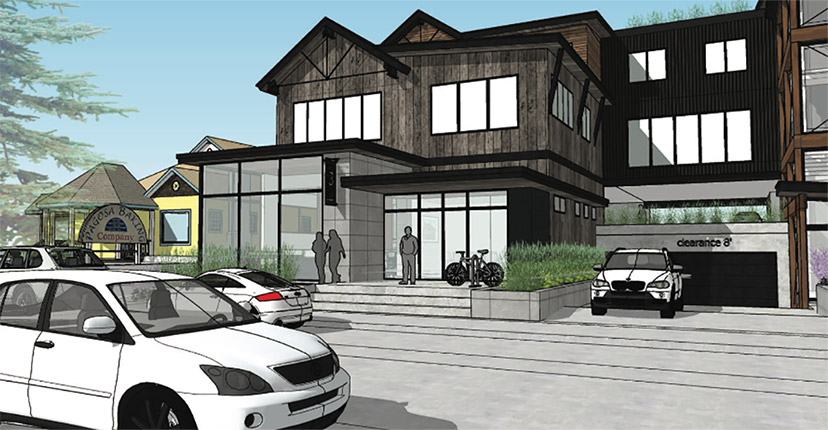As reported on Friday, in Part Three, the Pagosa Springs Town Council listened carefully to the arguments for and against the preliminary approval of a rather massive, three-story mixed use building proposed for three vacant lots at the address now known as 232 Pagosa Street, and located between two popular East Village businesses — the Pagosa Baking Company and the Alley House Grille. The dwellings that had once occupied these now-vacant parcels were demolished by developer David Brown back in 2006. Mr. Brown later proposed a two-story mixed-use building — commercial downstairs and residential upstairs — but didn’t live long enough to see the project constructed.
The new proposal for those same three parcels is significantly more massive than what Mr. Brown had proposed, but the Town Council, last week, affirmed the Planning Commission sketch approval of that massive building.
Granted, the word ‘massive’ is relative. Which is to say, relative to whatever is located nearby.

Two couples with nearby property — Robert and Sarah Nemeth, and Kathy Keyes and Kirsten Skeehan — had availed themselves of the right to appeal the Planning Commission approval to the Town Council, and presented cogent arguments that the project violated the intent of the Land Use and Development Code (LUDC) and the official Downtown Master Plan. Architects Brad Ash and Lauren Davis argued in favor of upholding the Planning Commission approval, as did the owner of the 232 Pagosa Street property, Martin Rose.
I’d like to quote some comments from Ms. Skeehan’s testimony, delivered near near the end of the hearing.
“One of the things I wanted to talk about was ‘voluntarily making things smaller.’ We’ve been hearing about the Town Terrace, a lot. And I don’t know if you recall, when that application first went out, they were asking for a variance on the [number of required] parking spots, because the design was bigger than it finally ended up being, and they didn’t have enough room for the required parking.
“So we went to [developer] Susan Winter Ward and said, ‘Why don’t you just make it smaller?’ And she did. So instead of looking for a variance, she just plain made it smaller, which we really appreciated…”
Here’s is a photo of the two-story Town Terrace, with commercial on the bottom floor and mainly residential on the top floor. It was designed by Reynolds Ash & Associates, who are also designing 232 Pagosa Street.

The Town Terrace is still one of the largest building in the East Village — but much smaller than the proposed three-story building proposed for 232 Pagosa Street.
Ms. Skeehan continued.
“[A reduction in size] can be done voluntarily. It doesn’t have to be, ‘Alright, I’ve got this piece of land; I’m going to build it as big as I can, because that’s the way to go…”
“Supreme Court Justice Potter Stewart famously said, in his 1964 order, that he could not use words to describe pornography, ‘but I know it when I see it.’
“And that’s how I feel about the mass of this project. That’s what the Downtown Master Plan was trying to clarify when using terms like, ‘mass and scale that reflects existing residential building size’… ‘respecting the scale of adjacent buildings’… ‘traditional setbacks’… ‘smaller scale buildings’… ‘open space and yards between’… ‘limiting lot consolidations in order to create natural breaks in building facade widths that emulate historical development patterns.’
“[Architect] Brad Ash gave a good discussion about how much experience he has interpreting the LUDC. And he comes to that interpretation from the point of view of an architect. His job is to fit as much building for the buck as he can on the given space, so he’s going to interpret it that way.”
Speaking as a citizen who has felt compelled to challenge certain local government actions in District Court, I can agree that many of the serious disagreements sparked by government decisions — and business decisions, and human decisions, in general — come from different interpretations of the very same words.
Take ‘smaller scale buildings’, as one example. Three words, written in a certain pattern, and open to interpretation. If you compare the three-story structure proposed for 232 Pagosa Street with the neighboring buildings, it is definitely not ‘smaller scale.’ Here’s a view of the proposed building footprint, compared to its existing neighbors, based on a drawing shared by the architects last Thursday:
But if you choose instead to compare 232 Pagosa Street to, say, the 98,000 square-foot Walmart store uptown, you can easily argue that the proposed structure is a ‘smaller scale building’.
That works, if you isolate each phrase from its context. As soon as you put ‘smaller scale buildings’ within the same paragraph as ‘respecting the scale of adjacent buildings’… your comparison to Walmart becomes disingenuous.
I don’t see how anyone who has bothered to read the Town’s 135-page Downtown Master Plan, with the goal of honestly understanding its original intent, could approve the 232 Pagosa Street proposal.
But a person who doesn’t care about the Plan’s original intent — say, developer seeking to build the largest possible building on three vacant lots, with the maximum square footage allowed, and the maximum height allowed — such a person can quote pieces of the LUDC and the Downtown Master Plan and make it sound like he (or she) is doing exactly what those documents allow, and nothing more.
It’s called ‘interpretation’ and you can make a lot of money doing it.
Last Thursday, the Town Council — following in the footsteps of the Planning Commission — were swayed by ‘interpretation’ and lost sight of the community plans that their constituents helped write over the past 15 years.
We will close with a few more words from Ms. Skeehan:
“The Town staff had an interpretation. And then the Design Review Board had an interpretation. And as an appeal, the only thing we can do is appeal an interpretation. We can’t appeal anything else about this. When you look at the rules of appeal, that’s what we get to appeal.
“We believe the Design Review Board did not interpret the Land Use and Development Code, and the Downtown Master Plan, correctly. It’s all about interpretation, and we just think it didn’t happen right.”
I agree.


